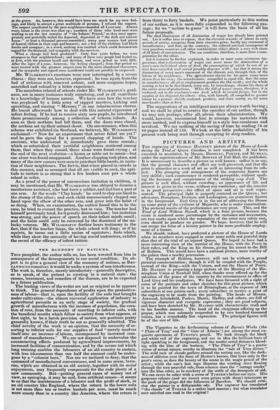The Vignettes to the forthcoming volume of Byron's Works (the
"Plain of Troy" and the " Gate of Athens") are among the most ex- quisite specimens of TURNER'S pencil. We look through the black and white veil of the engraving, and see in idea the brilliant hues of light sparkling in the foreground, and the tender aerial distances blend- ing with the blue of the • horizon. "The Plain of Troy" is a poetic vision of actual nature, worthy to illustrate the "tale of Troy divine."' The wild rack of clouds gathers around the setting sun, like the dark- ness of oblivion over the fame of Homer's heroes, that lives only in the poet's verse, as does the beauty of the scene in the magic pencil of the artist ; while the sun's last rays illumine the winding river flowing through the now peaceful vale, from whence rises the "cottage smoke" into the blue ether, as in mockery of the strife of the demigods of old.. We can never be sober with a scene of TURNER'S before our eyes. His. gorgeous colours (and we invest even prints with them) intoxicate as the gush of the grape did the followers of Bacchus. We should criti- cise the painter in a dithyrambic ode. The engraver has translated "the clouds" of TURNER in a rather hard manner; but wtat translator ever satisfied one read in the original ?



























 Previous page
Previous page